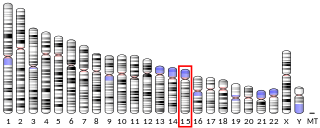
Leucine-rich repeat-containing G-protein coupled receptor 4 is a protein that in humans is encoded by the LGR4 gene. LGR4 is known to have a role in the development of the male reproductive tract, eyelids, hair and bone.

Transmembrane and Tetratricopeptide repeat containing 4 is a protein that in humans is encoded by the TMTC4 gene. This protein crosses the plasma membrane 10 times, and resides in the ER lumen and cytosol. The predicted structure of the TMTC4 protein is a series of alpha-helices.

Tetratricopeptide repeat protein 1 is a protein that in humans is encoded by the TTC1 gene.

Tetratricopeptide repeat protein 3 is a protein that in humans is encoded by the TTC3 gene.

Transmembrane and TPR repeat-containing protein 2 is a protein that in humans is encoded by the TMTC2 gene.

Tetratricopeptide repeat protein 4 is a protein that in humans is encoded by the TTC4 gene.

Junctophilin 4 is a protein in humans that is encoded by the JPH4 gene.

Tetratricopeptide repeat domain 28 is a protein that in humans is encoded by the TTC28 gene.

Transport and Golgi organization protein 6 homolog also known as transmembrane and coiled-coil domain-containing protein 7 is a protein that in humans is encoded by the TANGO6 gene.

Tetratricopeptide repeat and ankyrin repeat containing 1 is a protein that in humans is encoded by the TRANK1 gene.

Motile sperm domain containing 1 is a protein that in humans is encoded by the MOSPD1 gene.

SID1 transmembrane family member 2 is a protein that in humans is encoded by the SIDT2 gene.

Leucine-rich repeats and death domain containing 1 is a protein that in humans is encoded by the LRRD1 gene.

Leucine rich repeat and fibronectin type III domain containing 4 is a protein that in humans is encoded by the LRFN4 gene.

Tectonin beta-propeller repeat containing 1 is a protein that in humans is encoded by the TECPR1 gene.

Transmembrane and immunoglobulin domain containing 1 is a protein that in humans is encoded by the TMIGD1 gene.

Prolyl 4-hydroxylase, transmembrane is a protein that in humans is encoded by the P4HTM gene.

CKLF like MARVEL transmembrane domain containing 6 is a protein that in humans is encoded by the CMTM6 gene.

Kelch repeat and BTB domain containing 11 is a protein that in humans is encoded by the KBTBD11 gene.

Transmembrane 6 superfamily member 1 is a protein that in humans is encoded by the TM6SF1 gene.




















